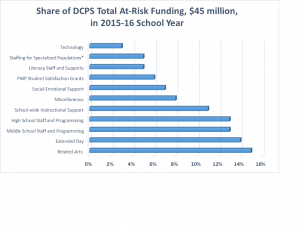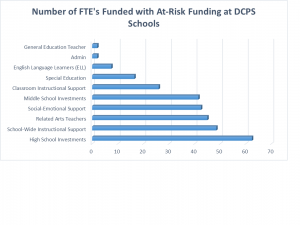Chancellor Henderson, thank you for the opportunity to speak today. My name is Soumya Bhat, and I am the Education Finance and Policy Analyst at the DC Fiscal Policy Institute. DCFPI is a non-profit organization that promotes opportunity and widespread prosperity for all residents of the District of Columbia through thoughtful policy solutions.
I’d like to take this opportunity to discuss two aspects of DC Public Schools (DCPS) budgets — the improved budget planning timeline and the strategic use of “at-risk” funding in schools.
Improved Budget Development Timeline
At last year’s DC Public Schools budget hearing, DCFPI testified about the need to extend the extremely short budget development timeline given to schools every year. We are so glad to see that DCPS is starting fiscal year (FY) 2017 budget planning and engagement in November and plans to give schools their initial allocations in February — a month earlier than usual. While there may still be changes that will need to be made after the Mayor sets the official “mark” for schools in March, this shift in the budget timeline will give schools a much-needed cushion to make budget decisions. Moving up the DCPS budget timeline will also give principals, LSATs, and parents a greater say in their school’s budget next year. We look forward to seeing this timeline in action.
Strategic Use of “At-Risk” Funding
Second, I’d like to speak to the strategic use of “at-risk” funding within DCPS. Now in its second year of implementation, these resources were added to the school formula to help our high-poverty schools provide programming and supports for students considered the most at-risk of academic failure due to poverty. This year, DCPS received nearly $45 million in at-risk funding, which was allocated proportionally to schools. (See charts below for a breakdown of uses.)
This funding represents a great opportunity for schools that serve large numbers of low-income students, and we’d like to see it allocated as strategically as possible to meet each school’s needs. We believe the funding was distributed this school year with limited flexibility for schools. Principals were given a set of choices to use this funding, many of which were pre-existing DCPS priorities, such as extending the school day, middle and high school staffing, and arts programming in elementary schools. We’d like to ensure that there is more flexibility for principals and LSATs to agree on using the funds to meet an unmet need in their school — for example to provide quality before- and afterschool programming, adopt new parent engagement strategies, or to offer more supports for homeless students.
It is also important to ensure at-risk funds are used to enhance school resources and not fill gaps in core staffing which should be funded adequately. A scan of FY 2016 school budgets indicates about one-third of these resources may be being used to supplant, rather than supplement local school budgets for general education purposes. If this is to be a trend, there needs to be a better way to distribute at-risk funds to schools.
This budget season, we encourage DCPS to use the earlier timeline to really engage with school principals about their needs and educate principals and LSATs on the unique opportunity provided by at-risk funding. This could mean developing a written plan, including how the funds are enhancing school staffing and programming, or allowing principals to make the case for certain uses at their school. We also recommend that, as schools develop their budget proposals, they include a narrative description of how they propose to use their at-risk funds, as a way of ensuring each school considers using these funds intentionally.
Thank you again for the opportunity to offer input on the FY 2017 DCPS budget. I am happy to answer any questions.


